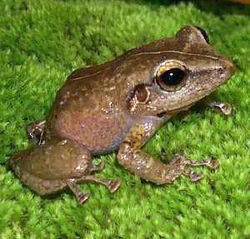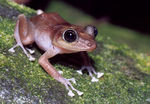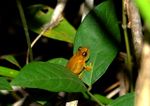Common coquí
| Common coquí |
|---|

|
| Scientific Classification |
|
| Scientific Name |
|
Eleutherodactylus coqui |
The Common coquí is a species of tree frog known by the scientific name Eleutherodactylus coqui. It is a symbol of pride for Puerto Ricans everywhere, as it is the nation's own unofficial mascot. Loved by many, the tiny frog has much meaning and is very charming with it's unique mating call and adorable face. While it is very beloved on the island of Puerto Rico, on the islands of Hawaii it is a widely known invasive species that causes much harm and annoyance.
Body Design
Male coquís typically measure between 30 and 37 millimeters, while females are often times significantly larger, ranging from 36 to 52 millimeters. [2] This size difference is commonly known as sexual dimorphism , in which the female in any species is larger than the male for breeding related purposes. Most often, the coquí has a brown, yellow, or green color. While small, at just 1-2 inches long, the frog is one of the largest on the island of Puerto Rico, its native habitat. [3]
Unlike most frogs, the common coquí does not have webbed toes, and so it does not know how to swim. In fact, the scientific name Eleutherodactylus literally means "free toes".[3] .Even so, the frog, like all other tree frogs, does have toe pads that allow them to climb completely vertical structures, such as trees, and cling onto leaves and wet, slippery surfaces. [2] [3]
Life Cycle
Coquís reproduce year-round in Puerto Rico, but the majority of mating occurs during the wet season of summer. The frog uses internal fertilization and are frogs the moment they are born, rather than passing through a tadpole stage. This means that the mother does not have to lay her eggs in water as an amphibian normally would. Coquís typically lay between 4-6 clutches of eggs with around 28 eggs in each clutch. The eggs then develop for around a month before hatching and releasing fully-formed and functional tiny frogs. Males commonly guard the eggs to make sure that they do not dry out and they remain in the nest for several days after the eggs have hatched. [4]
The call that a male coquí uses in mating is composed of two separate noises- "co", to threaten any males, and "qui", which attracts females. Once a nest has been established, both the male and female frog exhibit very territorial behavior and will fight off any intruders on their nest by chasing them away, jumping on them, and sometimes even biting. [5]
No one knows definitively how long the common coquí lives, but frogs as old as 6 years old have been found individually. However, scientists predict that up to 94% of coquís do not live past the first year of their life. [5]
Ecology
The common coquí[5] lives all over the island of Puerto Rico, and also the island of Hawaii, though it is only native to the first. Within the rainforest, the frog lives anywhere from the understory to the canopy. Juvenile coquís eat small prey like ants, but adult frogs can eat organisms such as spiders, moths, crickets, and snails. They may even eat a frog that is smaller than them! Even though they have a very diverse diet, over half of what they eat is roaches, crickets, and ants, because that is what is widely available in the forest. [5]
Predators of the coquí include birds, snakes, and large spiders. To protect itself when threatened, the frog will hide under leaves and undergrowth on the floor of the rain forest. Their coloration also serves as camouflage. [5]
While seen as a nuiscence by many, the common coquí is very important in keeping the ecosystem of the Puerto Rican rain forests healthy. For larger predators, they serve as prey. For humans, they are very helpful in keeping the pest population under control, since they often live in parks and near homes. However, while helpful in Puerto Rico, they are an invasive species to Hawaii and are very problematic there. [5]
Invasive Species
Currently in the state of Hawaii, the common coquí is classified as a rapid response species on all of the islands. While its insect eating abilities come in handy in its native land of Puerto Rico, they destroy huge amounts of insects, and thus they are disrupting the very delicate balance of the ecosystems all around the islands. This loss of insects is even more devastating because these insects serve as very important pollinators. Also, while a part of Puerto Rican culture and a widely known fact, the coquí's loud "ko-kee" call is very disruptive to those who aren't used to it, especially while trying to sleep. This annoyance also affects Hawaii's tourism industry.[6]
Coquís are very small and only move 6 meters in one night, on average. However, if they hitch a ride on a truck or nursery flower, they can be spread around very quickly. As said directly by the Hawaiian Invasive Species Council, or HISC, "Coqui frogs do not travel very far on their own, but when given the chance to hop on a nursery plant, flowers, or vehicle, they can quickly spread. Most coqui arrive on new islands through infested nursery plants and flowers. Intra-island, coqui travel by the movement of plants by humans and may hitch a ride on vehicles. The coqui frog is currently widespread on the island of Hawaii, but is only known to be in a few locations on the island of Maui, Kauaʻi, and Oʻahu. They are not present on Molokaʻi or Lanaʻi. " [6]
Video
Here is a video showcasing the sound that the coquí makes. It sounds like its name!
References
- ↑ Common Coqu Wikipedia. Web. Month Day, Year. Author unknown.
- ↑ 2.0 2.1 Common Coquí Wikipedia. Web. Accessed January 16, 2017. Author unknown.
- ↑ 3.0 3.1 3.2 Puerto Rican Coqui National Wildlife Federation. Web. Accessed January 16,2017. Author unknown.
- ↑ Rivera, Magaly. The Coqui To Puerto Rico. Web. Accessed January 16, 2017.
- ↑ 5.0 5.1 5.2 5.3 5.4 5.5 Maiorana, K. Eleutherodactylus coqui Animal Diversity Web. Web. Accessed January 16, 2017.
- ↑ 6.0 6.1 COQUI FROG (ELEUTHERODACTYLUS COQUI) Hawaii Department of Land and Natural Resources. Web. Accessed January 18, 2017. Author unknown.



